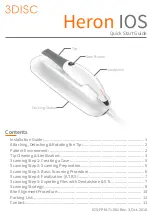
3
Fig. 1
Abb. 1
Bahnsteiggleisen und der Einmündung von Abstellgleisen.
In Rangierbereichen sollten die Sperrsignale so dicht wie
möglich am Gleis stehen, d. h. direkt vor dem Grenzzei-
chen oder dem Weichenanfang. Zwischen den Gleisen
sollte dabei mindestens ein Abstand von 51 mm (H0), 37
mm (TT), 28 mm (N) bzw. 20 mm (Z) zur Aufstellung des
Signals vorhanden sein.
Die Signalschirme sind mit wartungsfreien LEDs bestückt.
3. Signaltechnik
3.1 Lichtsignalkabel zuordnen
Die Anschlusskabel der Lichtsignale sind farbig markiert und ha-
ben an den Enden einen Widerstand. Das Kabel der weiß/gel-
ben LED (Sh1) trägt eine weiße/gelbe Markierung, das Kabel
der roten LED (Sh0) trägt eine rote Markierung. Das Anschluss-
kabel mit schwarzer Markierung und Diode ist der gemeinsame
Rückleiter für alle LEDs (Pluspol). Viele weitere Informationen
über Signale finden Sie im Viessmann Signalbuch, Art. 5299.
Die Signalbegriffe der Lichtsignale zeigt Abb. 1.
areas e. g. at the end of the station tracks and the branch
of sidings.
Stop signals should be as close to the end of the track as
possible, that is directly in front of the shunting limit signal
or at the beginning of the turnout. The distance between the
tracks should be at least 51 mm (H0), 37 mm (TT), 28 mm
(N) resp. 20 mm (Z) to allow sufficient space for the signal.
The signal shield have maintenance free LEDs.
3. Signal technique
3.1 Assign cables
The cables of the colour light stop signals have coloured
markings and a resistor. The cable of the white/yellow
LEDs (Sh1) has a white/yellow marking, the cable of the
red LEDs (Sh0) has a red marking The cable with the
black marking and a diode instead of a resistor is the com-
mon pole for all LEDs (positive pole).
Fig. 1 shows the aspects of the colour light signals. For
more information regarding signals please see Viessmann
signal book, item 5299 – German language.
Sh0
„Halt! Fahrverbot!“
“Stop!
Driving prohibited!“
Sh1
„Fahrverbot
aufgehoben“
“Driving allowed“
Hinweis:
Beim Vorbild wird
das Signalbild Sh1 mit wei-
ßen Lampen dargestellt.
Unsere Modelle enthalten
weiße bzw. gelbe LEDs.
4. Einbau
- Nehmen Sie das Signal vorsichtig aus der Verpackung.
Führen Sie vor dem Einbau eine Funktionskontrolle durch.
- Dem Signal ist ein Etikett mit selbstklebenden Bezeich-
nungsschildern beigelegt. Schneiden Sie die gewünsch-
ten Bezeichnungsschilder aus und kleben Sie es nach
Abziehen der Schutzfolie auf den Signalkasten auf.
- Bohren Sie an der Montagestelle ein Loch (Ø 3,5 mm).
- Führen Sie die Anschlusskabel von oben durch das
Montageloch und stecken Sie dann das Signal mit dem
Patentsteckfuß hinein. Falls erforderlich, Haltering von
unten auf den Steckfuß stecken.
5. Anschluss
Vorsicht:
Widerstände und Diode an den Enden der Anschlusska-
bel sind für die Funktion erforderlich. Keinesfalls entfer-
nen! Widerstände nicht mit Isolationsmaterial umhüllen,
da sonst keine ausreichende Kühlung möglich ist!
Sie können dieses Signal flexibel anschließen:
- Direkt per Schalter an einen Modellbahntrafo (Abb. 2).
- An ein Viessmann Steuermodul mit Tasten-Stellpult (Abb. 3).
Wir empfehlen die Verwendung des Steuermoduls Art.
5221 und des Tasten-Stellpults Art. 5547. Dann verfügt
das Signal über weichen Lichtwechsel und Zugbeeinflus-
sung. Für Digitalbetrieb eignen sich der Schaltdecoder Art.
5213 für Märklin (Motorola) und der Multiprotokoll-Schalt-
decoder Art. 5285.
4. Mounting
-
Remove the signal from the box carefully. Check the
function prior to mounting.
- Adhesive labels are supplied with the signal. Simply cut
out the desired sign and attach it to the signal box after
removing the protection foil.
- Drill a hole (Ø 3,5 mm) at the mounting place.
- The signal‘s connection cables have to be insert-
ed into the hole first. Then put the signal with the
patented base socket into the hole. If necessary,
plug the retaining ring from the bottom onto the base
socket.
5. Connection
Caution:
Resistors and diode at the cables are needed for proper
function of the lamp. Never cut them off! Never cover the
resistors with insulation material, because they have to
be cooled by surrounding air!
You can connect the signal very flexible:
- Via switch directly to a transformer (fig. 2).
- To a Viessmann control module with push button panel (fig. 3).
We recommend to use a control module item 5221 and the
push button panel item 5547, which offer smooth change of
the lights, train control. For digital operation we recommend
the switching decoder item 5213 for Märklin (Motorola) and the
multi protocol switching decoder item 5285.
LED rot
LED red
LED weiß/gelb
LED white/yellow
Hint:
In the model, the sig-
nal image Sh1 is shown
with white lamps. Our mod
-
els contain white resp. yel
-
low LEDs.






















